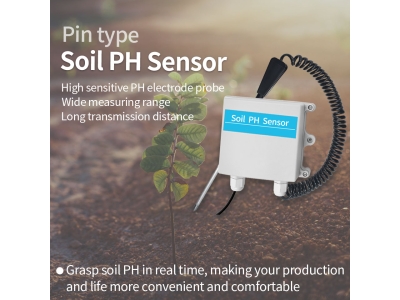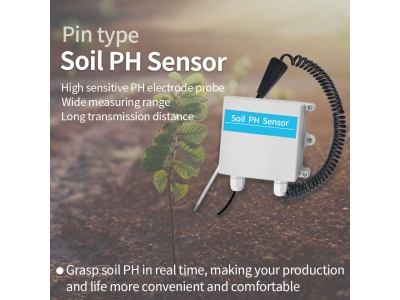Farming has been the backbone of human civilization since time immemorial. Over the centuries, technological advancements have revolutionized agricultural practices, enabling farmers to produce more food with greater efficiency. In recent years, one such innovation that holds immense promise for the future of farming is the development and use of soil sensors. These devices allow farmers to gather real-time data on various soil parameters, empowering them to make informed decisions and optimize crop production. This article explores the significance of soil sensor innovation in advancing agriculture and the potential benefits it offers to farmers.

The Role of Soil Sensors in Precision Farming
Precision farming, also known as precision agriculture or smart farming, is an approach that utilizes technology to manage agricultural practices with a high level of accuracy and efficiency. Soil sensors play a crucial role in precision farming by providing farmers with detailed information about the soil conditions in their fields. Let's delve into some key areas where soil sensors contribute to precision farming:
Soil Moisture Monitoring
Water is a fundamental requirement for plant growth, and maintaining optimal soil moisture levels is paramount for crop health. Soil sensors enable farmers to continuously monitor soil moisture content, helping them determine when and how much water to apply to their fields. This information allows for precise irrigation scheduling, preventing under or over-watering. By avoiding water stress or waterlogging, crops can thrive and achieve their maximum yield potential. Moreover, efficient water management reduces water usage, conserves this valuable resource, and minimizes irrigation costs for farmers.
Nutrient Management
Plants require essential nutrients for healthy growth and productivity. Soil sensors provide accurate and timely data on the nutrient levels present in the soil, allowing farmers to optimize their fertilization practices. By analyzing these readings, farmers can identify nutrient deficiencies or excesses and adjust their fertilizer applications accordingly. This enables them to provide crops with precisely the nutrients they need, avoiding wastage and reducing the risk of nutrient leaching into water bodies. Effective nutrient management not only improves crop yields but also promotes environmental sustainability.
pH Monitoring and Soil AmendmentsSoil pH directly affects nutrient availability to plants. Different crops have specific pH requirements for optimal growth. Soil sensors help farmers measure soil pH levels accurately, enabling them to identify if the soil is too acidic or alkaline. Based on these measurements, farmers can take appropriate actions, such as adding lime to raise pH levels or sulfur to lower pH levels. The ability to amend soil pH ensures that crops can access the necessary nutrients, maximizing their growth potential and overall productivity.
Temperature Monitoring for Planting Decisions
Soil temperature plays a crucial role in seed germination and plant development. Soil sensors provide farmers with real-time data on soil temperature, assisting them in making informed decisions about the ideal planting times for different crops. By taking into account soil temperature readings, farmers can optimize their planting schedules. This helps ensure that seeds germinate successfully, leading to robust plant growth and increased yields. Additionally, precise planting decisions contribute to efficient resource utilization and minimize the risk of crop failure due to unfavorable conditions.
Benefits of Soil Sensor Innovation
The use of soil sensors in precision farming offers several significant benefits to farmers:
Increased Crop Yields: By providing farmers with precise and timely information about soil conditions, soil sensors empower them to make data-driven decisions. This enables farmers to optimize their agricultural practices, resulting in improved crop yields and enhanced productivity.
Resource Efficiency: Soil sensors enable farmers to apply irrigation water, fertilizers, and other inputs precisely as needed. This reduces resource wastage, conserves water, minimizes fertilizer runoff, and promotes sustainable farming practices. Efficient resource management not only benefits the environment but also reduces costs for farmers.
Cost Savings: By leveraging soil sensor technology, farmers can optimize their use of resources and inputs. This leads to cost savings in terms of water, fertilizers, energy, and labor. Additionally, by preventing crop losses due to improper irrigation or nutrient deficiencies, farmers can protect their investments and maximize profitability.
Environmental Sustainability: Precision farming practices driven by soil sensor data contribute to environmental sustainability. By reducing the use of water and minimizing the release of nutrients into water bodies, soil sensor innovation helps mitigate the negative impacts of agriculture on ecosystems. This promotes long-term soil health, biodiversity conservation, and water resource protection.
Challenges and Future Directions
While soil sensor innovation has immense potential, there are challenges that need to be addressed for wider adoption and implementation:
Cost: The initial investment in soil sensor technology can be significant, especially for small-scale farmers. However, as technology advances, costs are expected to decrease, making soil sensors more accessible to a broader range of farmers.
Data Interpretation: Soil sensor data can be complex, and proper interpretation requires technical expertise. It is crucial to develop user-friendly interfaces and analytical tools that enable farmers to understand and utilize the information effectively.
Calibration and Maintenance: Soil sensors need to be calibrated periodically to ensure accurate readings. Additionally, regular maintenance is necessary to address any technical issues that may arise. Educating farmers about calibration and maintenance procedures will be essential for successful adoption.
The future of soil sensor innovation in agriculture looks promising. Ongoing research and development efforts focus on improving sensor accuracy, durability, and affordability. Integration with other advanced technologies, such as remote sensing, satellite imagery, and artificial intelligence, holds immense potential in enhancing the capabilities of soil sensors. These advancements will provide farmers with comprehensive insights into their fields and enable them to make more informed decisions.
Conclusion
Soil sensor innovation is sowing the seeds of precision farming, revolutionizing agriculture and shaping the future of food production. By providing real-time data on soil moisture, nutrient levels, pH, and temperature, soil sensors empower farmers to optimize their practices and achieve higher crop yields. Moreover, they promote resource efficiency, cost savings, and environmental sustainability. As technology continues to advance and becomes more accessible, soil sensors will play a vital role in nurturing crops from the ground up and ensuring food security for future generations. With precision farming powered by soil sensor innovation, agriculture is poised to meet the challenges of a growing global population and contribute to a sustainable and prosperous future.






